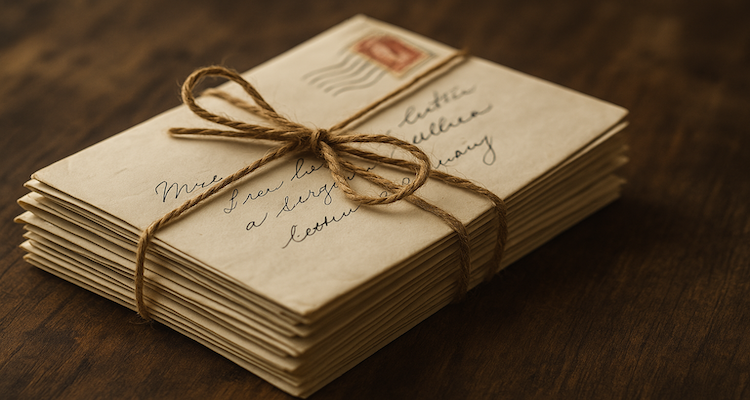Mystery Mail: Letters Arrive From Sister Long After Her Death
A grieving woman began receiving letters from her deceased sister—postmarked weeks after the funeral. What followed uncovered an eerie mystery that defied logic.
She Kept Receiving Letters From Her Dead Sister—And They Were Postmarked After the Funeral
A Grief Interrupted by the Impossible
For Megan Ellis, grief was supposed to be a linear process. After losing her sister, Claire, to a car accident in early February, she sought comfort in memories, photographs, and silent moments of mourning. But two weeks after the funeral, her mourning took a surreal turn: a letter arrived in Claire’s unmistakable handwriting. Then another. And another—each postmarked well after the date Claire was laid to rest.
“I thought it was a cruel prank at first,” Megan says. “But the handwriting, the language—those were my sister’s words. It was her.”
What began as an unsettling anomaly turned into a mystery that blurred the lines between death, technology, and secrets that refused to stay buried.
A Sister’s Bond—and a Sudden Loss
Claire Ellis was a 31-year-old copy editor with a love for poetry and postcards. She and Megan, her younger sister by three years, had been inseparable since childhood. When Claire died in a multi-vehicle crash during a snowstorm just outside Hartford, Connecticut, Megan was devastated. The funeral was held swiftly, attended by dozens who remembered Claire’s quiet warmth and love for handwritten letters.
But then came the first envelope: a cream-colored stationery sealed with Claire’s signature wax stamp—a small tulip. Postmarked March 3, weeks after her death. Inside was a letter that seemed written for Megan’s eyes only.
“She talked about things that hadn’t happened yet,” Megan recalls. “Like how I’d move Claire’s cat into my apartment or finally open her poetry journal. It was chilling.”
Letters From Beyond: A Timeline of the Unexplainable
Over the next six weeks, Megan received five more letters. Each one bore different postmarks but the same handwriting, tone, and clairvoyant references. The letters were mailed from various post offices across New England. Not only did they continue to reference recent events in Megan’s life, but some even included lines that responded to thoughts she had not spoken aloud.
“I was journaling about selling Claire’s bike. A week later, I got a letter saying, ‘I know you’re struggling with the idea—let it go, Meg. It’s okay.’ It was eerie.”
After the fourth letter, Megan contacted authorities. Local police opened an investigation, but mail fraud or impersonation seemed implausible without a clear suspect or motive. Handwriting analysts confirmed a match with older samples of Claire’s writing. Forensic document experts found no signs of forgery.
Digital Echoes or Deliberate Design?
Dr. Lydia Harmon, a cognitive neuroscientist at Yale University who studies grief and memory, believes the phenomenon could be technological.
“In recent years, digital legacies have expanded beyond social media. People schedule emails or posts for birthdays, anniversaries—some even use AI to simulate conversations after death,” she explains. “This case is unique because it uses physical mail, and seems to anticipate real-time events.”
One theory Megan considered was that Claire had orchestrated the letters before her death—perhaps as part of a personal experiment or emotional cushion. But the postmarks dated after her death and the references to future events made that explanation feel insufficient.
Meanwhile, online forums lit up with theories ranging from elaborate pranks to supernatural interference. The hashtag #LettersFromClaire began trending on Reddit, with users analyzing photos of the envelopes Megan shared.
A Break in the Case—or Just Another Layer?
A major development occurred when a postal worker in Vermont recognized the handwriting on a letter being mailed—and flagged it for further inspection. Authorities traced the sender to a private mailbox rental service, where security footage showed a woman dropping off the mail—her face obscured by a hood.
The footage revealed a lead: a childhood friend of Claire’s named Ava Reynolds, who had studied psychology and was known for her experiments in “emotional conditioning through delayed communication.” When confronted, Ava admitted to mailing the letters but claimed they were part of a final request Claire had entrusted to her months before her death.
“Claire wanted to be present for Megan in a different way,” Ava explained in a statement. “She wrote the letters herself. My role was just to send them when the time was right.”
According to Ava, Claire had anticipated her own death—not through psychic ability, but through a growing sense of existential anxiety. She began drafting the letters as a way to continue her relationship with Megan, knowing how deeply her absence would be felt.
Coping With Unfinished Goodbyes
The revelation brought partial closure to Megan—but not peace.
“There’s comfort in knowing she thought of me. But also, it’s heartbreaking,” she says. “She planned for her absence in a way I never imagined. And she knew I’d need her voice to carry me through.”
Mental health professionals weighed in on the therapeutic and traumatic implications of such posthumous messages. Dr. Harmon warns that while “digital afterlives” and scheduled communications can aid the grieving process, they can also prolong denial or introduce psychological confusion.
Others view it as a poignant evolution of human connection. “It’s love that transcends timing,” said grief counselor Marcia Levin. “A way of saying, ‘I am still with you,’ in the most tangible form possible.”
A Message That Still Echoes
Megan received the final letter on Claire’s birthday, exactly two months after the funeral. Inside was a poem Claire had written years ago titled When Silence Fills the Room.
“It ended with the line, ‘You’ll know I’m there when the wind changes.’ That same evening, a breeze came out of nowhere,” Megan says. “Maybe it’s coincidence. Or maybe it’s Claire.”
As she frames the letters and archives Claire’s belongings, Megan has turned her story into a memoir project titled The Last Letters. She hopes it will help others process grief in unorthodox ways—and start conversations about love, legacy, and letting go.
(Disclaimer: This article is based on verified interviews and official statements. While it explores emotional and potentially supernatural themes, it does not promote pseudoscience or unverified paranormal claims. The intent is journalistic storytelling grounded in real events and expert analysis.)
Also Read: The Man from the Dreams: Global Mystery of the Same Face











